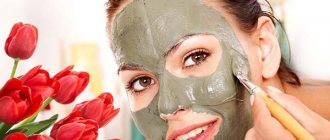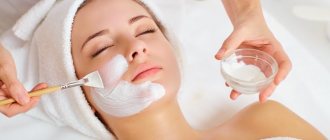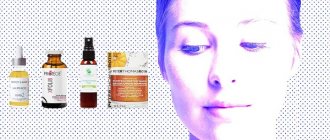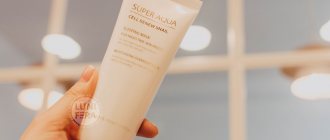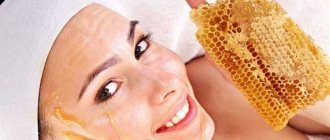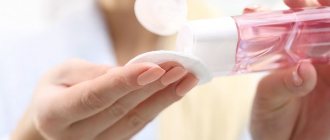Many women are interested in how often they can make face masks in order to maintain youth and freshness longer. But in pursuit of ideal skin, it is worth remembering that an excess of beneficial (no matter moisturizing or nutritional) components can cause harm and worsen the appearance.
Cleansing and peeling compounds should be used with caution.
To solve a clearly expressed problem, a course of masks is needed. But even in this case, their daily use is not always justified.
How often to make face masks: practical recommendations
The composition of each mask is individual. It will largely depend on the type of facial skin and the purposes pursued by its use. The exposure time of the masks will also differ from each other. The only things that remain virtually unchanged for all types of masks are the preparation procedure and the rules for applying them to the face:
- If the mask is prepared independently, then it must be kneaded immediately before application.
- Before covering your facial skin with the mask, it must be thoroughly cleaned with water and cosmetic gel, soap or lotion.
- It is advisable that the woman remain in a supine, relaxed position for the entire period the mask is on her face. You need to try not to show any emotions through facial expressions and not grimace
- The effect of the mask is enhanced if the skin has previously been steamed cold or hot.
- In order to achieve long-lasting results, all skin products must be applied strictly according to the instructions, and courses of treatment and prevention should preferably be repeated regularly.
- There is a special technique for applying a mask or cream to the face along massage lines: facial products are applied from the wing of the nose to the ear, from the center of the forehead to the temples, along the jawline from the center up and from the upper lip to the ear
- Residues or excess masks must be removed with a cotton pad soaked in cool water or special cosmetic wipes.
Frequent use is harmful
There are products with biologically active substances that help stimulate blood circulation and so on. They are not recommended to be used as a face mask every day.
Daily cosmetic procedures should be done by the age of forty, when the body's natural resources are running out. Vitamin and herbal remedies help the skin promptly restore dying cells, water and lipid balance. All masks at this age should be done before going to bed, first cleansing your face well.
How to properly apply a face mask?
As for the frequency of using a particular mask, the usual rule “The more often, the better” is not relevant here. After all, some components of the mask can have a tightening or drying effect with frequent use. Or, on the contrary, over-hydrate already oily facial skin. Therefore, you should apply the mask strictly based on the recommendations and skin type.
How often to use masks for different skin types?
Everyone knows that each skin type needs its own, individual care. With such care, the intensity of use of masks must also meet certain rules:
- Since oily skin is characterized by enlarged pores and a large amount of sebaceous secretions, it should be cleansed more often and moisturized less often. Therefore, nourishing masks in this case are applied no more than a couple of times a week, but cleansing and peeling masks can be used at least two to three times a week
- For those with normal skin, it will be enough to carry out cleansing procedures once a week and nourishing and moisturizing manipulations once a week.
- Dry skin is the most susceptible to flaking and drying out. Therefore, the entire range of measures for caring for this type of skin should be aimed at nourishing and moisturizing the epidermis (at least three times a week). At the same time, it is better to reduce any cleansing or scrubbing masks to a minimum (no more than once a week)
- The situation with combination skin is considered more complex. This type requires careful observation and identification of the dominant qualities of the skin. If the latter is prone to excessive sebum secretion, then moisturizing masks should be applied no more than once a week. If, on the contrary, it is too dry, it is advisable to soften it more often with the help of nourishing masks
- If your skin is sensitive, you can regularly use moisturizing masks (two to four times a week). However, you should ensure that they do not contain components that can cause allergic reactions. Also, sensitive skin is strictly prohibited from coming into contact with abrasive substances.
- Problem skin (rich in pimples, blackheads and blackheads) requires a whole range of care. Firstly, it needs to be cleaned regularly. Secondly, she needs nutrition and hydration. And finally, for problem skin it is advisable to use soothing and drying products. It is recommended to do each of the listed manipulations at least twice a week.
Rules for using masks
Among the main indications for the use of cosmetics, it is worth highlighting:
- presence of acne;
- pigmentation;
- the presence of irritation and redness on the skin;
- for oily and dry skin;
- the appearance of the first age wrinkles.
Considering the fact that clay is a natural material that does not cause any allergic reactions, the complete absence of medical contraindications is considered quite reasonable. However, to achieve maximum efficiency, it is worth considering some details:
- the mask complex is applied exclusively to clean skin;
- Do not apply cosmetics to areas around the eyes;
- mask components should not include products that cause individual allergic reactions.
Clay masks are suitable for almost everyone, but, like any other skin care product, it has a number of limitations for use:
- Individual intolerance to components
- Allergic reactions
- Chronic skin diseases
- Open wounds on the skin, purulent rashes.
- Skin with rosacea
Natural clay can cause allergies in very rare cases. The only question is to find an environmentally friendly and safe product. An adequate price/quality ratio and real reviews from other customers will help here. It is better to purchase clay in natural cosmetics stores.
How often can you make nourishing masks?
Nourishing face masks are designed to heal the skin and restore its excellent appearance. They saturate the epidermis with missing minerals, give it firmness and elasticity, and help smooth out surface wrinkles.
Nourishing masks are universal and suitable for all skin types. As mentioned above, it is necessary to use masks based on the type and condition of the skin. The frequency of use will also depend on this factor.
Industrially produced nourishing masks are recommended to be used about three to four times a week. Masks prepared with your own hands at home from natural ingredients can be used every day if your skin condition requires it.
How often can you make moisturizing masks?
As a rule, moisturizing and nourishing masks are usually used in combination. They complement each other perfectly and enhance the effect of their mutual impact. A moisturizing mask helps restore the skin's moisture balance and replenish the missing level of moisture.
The frequency of use of moisturizing masks absolutely coincides with the frequency of use of nourishing masks.
How often can you make anti-aging masks? How often can you make anti-wrinkle masks?
Closer to the age of thirty, telltale wrinkles may begin to appear on a woman’s face. They are not yet very noticeable and do not completely age their “lucky owner”, but it is advisable to start fighting them at the first sign of them.
Then you can delay the appearance of the next, deeper crow’s feet, as well as visually reduce and smooth out existing ones. For these purposes, it is necessary to use anti-aging masks, either industrial or homemade.
However, first you need to find out how often you can make anti-wrinkle masks. Regardless of the production of the mask, there are several constant and general rules regarding their use:
- The composition of the mask should correspond to your skin type. It should not contain components that can cause an allergic rash or irritation.
- You can use anti-aging masks from the age of twenty-five
- When preparing and applying the mask, you must strictly follow the recipe and instructions for use.
- Anti-aging masks are usually used about two to three times a week
- You should not skip procedures, otherwise the effect may be lost and you will have to start all over again
You can view and buy the COLLAMASK rejuvenating cream face mask here.
Mask recipes for daily use
You can use both store-bought and natural homemade face masks for every day; simple recipes will help you prepare them.
- Oatmeal will give your skin energy and tone it up. It is very easy to prepare a mask - to do this, pour hot water over ground oatmeal and leave for 10-15 minutes. The mask should be left on for at least 20 minutes.
- Yogurt is a source of energy and nutrients that the skin of the face sometimes lacks. The mask does not require preparation, just apply fresh natural yoghurt to the skin and rinse with cool water after 20 minutes.
- A cucumber mask will help refresh your skin and improve your complexion. To prepare, you need to grate the cucumber on a fine grater and apply the resulting pulp on your face for about half an hour.
The advantage of such masks is their simplicity and effectiveness. These products are not allergenic, and you only need one ingredient to prepare the product.
How do popular fabric and alginate masks work? How to store them? How long should I keep it on my face and how often should I use it? Brand expert Dr. answers. Jart.
Natalya Kormilina
expert Dr. Jart
Are moisturizing and lifting sheet masks really more effective than regular wash-off masks?
When comparing the effectiveness of fabric and cream masks, it is important to understand that we are comparing masks from the same price segment. In this case, yes, fabric masks act faster, provide an excellent beauty effect, are suitable for express care before going out, and allow you to immediately apply makeup. The woven base prevents moisture loss, enhances the penetration of active components and stimulates their maximum absorption.
What mistakes do women often make when
using fabric and alginate masks?
A) Wait for it to dry completely
The sheet mask is removed while it is still damp; if it dries on the face, it takes away some of the moisture from the skin due to the hygroscopic material. The mask should not be left on for longer than the time indicated on the package, and if the skin is very dry and dehydrated, then you need to keep it on even less.
B) Loose fit
Hydrogel and alginate masks need to be pressed tightly against the skin and bubbles removed - this way they work better.
C) Use the mask twice, putting it back into the bag after use.
The mask is sterile only until the package is opened. Bacteria multiply in the mask, which can cause irritation, rashes, and allergic reactions.
How can you tell a good sheet mask from a bad one?
The base of the mask is important; it must be made of high-quality microfiber/cellulose fabric that absorbs moisture and active ingredients well. The composition of the serum that impregnates the base is also important. And the easiest way to distinguish is by price.
How often can you make fabric and alginate masks?
Are there any contraindications for them?
Depending on the needs of the skin, you can do the course for a week every day, or once or twice a week for maintenance. In general, the phenomenon of Korean skin care is that they either do not use traditional creams or use them only in the morning, and in the evening they use different masks every day.
Alginate is an analogue of a salon procedure; once a week is enough.
Contraindications - acne in the acute phase for all fabric masks except those designed specifically for problem skin.
How to properly store such masks?
There are no special storage conditions. But fabric masks can be stored in the refrigerator for a decongestant and/or soothing effect.
Hydrogel masks should never be stored in the refrigerator: their exposure time is longer than that of fabric masks for a reason, because they begin to act only after the Hydrogel warms up to skin temperature. When it comes into balance, the transdermal delivery system begins to operate.
How often can you do whitening masks?
- Women who have any age spots, freckles on their faces, or simply want to improve their complexion and get rid of unwanted dark circles under their eyes, are recommended to use whitening masks at home. However, the frequency of use of such masks will directly depend on skin type
- Those with dry, sensitive skin should not repeat procedures with whitening masks more than once every two weeks. The same applies to women over forty years of age. This period is characterized by the appearance of age-related wrinkles and excessive dry skin.
- Women with normal skin type can use whitening masks once a week. What frequency is recommended for combination skin?
- Well, oily skin allows you to use such cosmetics about twice a week
That's all the recommendations regarding the frequency of use of various types of masks. The conclusion of this article is this: be sure to choose a mask according to your skin type, use it regularly, but do not overdo it!
Night
Young woman with clay facial mask.
After a hard day's work, the skin is in dire need of vitamins, minerals and other beneficial substances. That is why evening is the time for nourishing and cleansing face masks. To get the desired result, they need to be applied at certain hours:
- From 18 pm to 22 pm, cosmetics for cleansing are relevant. It will prepare the dermis for applying a nourishing mask.
- 22–23 hours is time to nourish the skin with vitamins and microelements.
- It is recommended to apply nutritional preparations half an hour before bedtime.
Each cosmetic brand produces products for day and night use. At the same time, moisturizing and toning masks work well in the morning and at lunchtime, and in the evening you need to nourish the skin with useful elements. Therefore, when choosing, be sure to pay attention to the mark at what time of day you need to apply the product.
There are many homemade masks. In the evening, vegetable and fruit compositions are often used. They have a calming, anti-inflammatory effect on the dermis.
Be careful when choosing recipes and use the product within the strictly prescribed time. The same goes for store-bought cosmetics. Of course, if you confuse day and night, your skin will not get worse, but you will also not be able to achieve positive results. If you don’t take care of your face at all, the dermis will lose its elasticity, many wrinkles will appear, and then you will look your biological age or even older.
